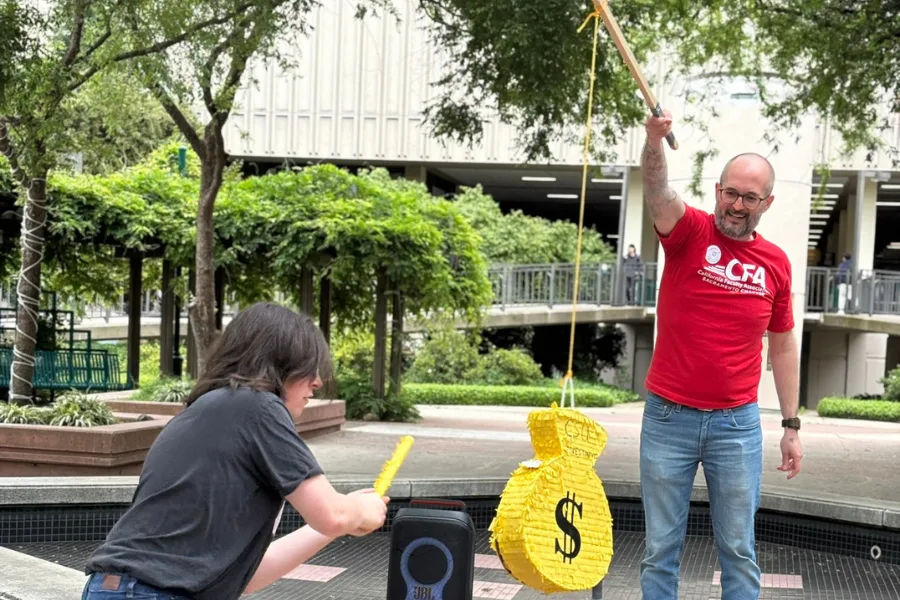CSU Board of Trustees Continues to Approve Exorbitant Compensation to CSU Executives
The California State University system officers and 22 campus presidents all make unjustifiable, exorbitant salaries and total compensation. Meanwhile, faculty wages stagnate and student tuition skyrockets.
CFA members decry how CSU management claims “limited funds are available” for faculty raises while the Board of Trustees has repeatedly increased executive compensation.

But we brought the issue to light, and it caused a lot of public outrage. Thus, while the board planned to give raises to seven of the system’s highest-paid executives on July 23, it only approved paying two new interim campus presidents the same salary as current presidents. Let’s keep pushing hard to make sure workers are fairly compensated before presidents and executives.
It is unconscionable how opaque the periodic presidential salary assessment is for campus presidents. The requirement for a satisfactory evaluation to receive a market-based salary increase means little when the triennial review process isn’t public.
The lowest-paid full-time lecturer makes just over $66,000 a year, but most lecturers are not full-time and make less than half that amount. In comparison, the lowest-paid CSU campus president makes $370,000 a year and gets housing provided. That’s a 460% difference, or roughly what five full-time lecturers make.
The average campus president makes a base annual salary of $450,285. That’s almost double the annual salary California’s governor collects, which was $242,000 as of December 2024. It’s also higher than the $400,000 the President of the United States makes per year.
Back in 2005, campus presidents made an average base annual salary of $249,000. That means the average base annual salary has increased by 81% in the past 20 years. Meanwhile, inflation between January 2005 and January 2025 was 63%. Taxpayers of California are funding the equivalent of over 20 U.S. presidential salaries. While CSU presidential salaries are staying way ahead of inflation, the same can’t be said for CSU faculty and staff salaries.
The chancellor’s base salary has increased 84.6% in just the last 10 years from $430,746 in 2015 to $795,000 annually in 2025. In comparison, inflation between January 2015 and January 2025 was 35.9%. Mildred García also receives $96,000 a year for housing, $80,000 in deferred compensation, and an annual car stipend of $12,000. This doesn’t include the tens of thousands of dollars she collects as a board member of the Educational Testing Service (ETS), which recently announced a partnership with the CSU.
García began her tenure as chancellor in October 2023 and makes 27% more than her predecessor Joseph Castro. When hired in September 2020, Castro made 30% more than his predecessor Timonthy White.
There are six other systemwide executive officers in addition to the chancellor. The five filled positions all make more than $300,000 annually. The Executive Vice Chancellor for Academic & Student Affairs position is currently vacant.
High salaries for making cuts
Interim Sonoma State University President Emily Cutrer makes $381,408 annually, despite announcing plans in January to cut more than a dozen majors and eliminate the university’s athletics programs. She also receives a $60,000 housing stipend each year. Cutrer also serves as a consultant with Chancellor García’s former employer, the American Association of State Colleges and Universities (AASCU).
In January, Cutrer reportedly told the Sonoma State Academic Senate, “Yes, I ultimately had to decide what to do. And no, I guess I won’t be held accountable in terms of my job, because I am interim.” In April, the same body passed a resolution of no confidence in Cutrer.
Cutrer was appointed to lead the university in 2024. Now, she is planning to use much of that $45 million state investment for expanding campus facilities, building administrative partnerships, and expanding already existing academic programs (rather than restoring cut programs). We take issue with her preemptively spouting austerity messaging.
CSU East Bay President Cathy Sandeen each year receives a $458,134 salary and $60,000 housing stipend, despite enrollment at the university falling almost 26% between 2016 and 2023. She has been president since 2020 and has failed to reverse the trend. Sandeen cut staff and administrator jobs in 2023 and also laid off faculty in 2024.
San Francisco State University President Lynn Mahoney makes $472,857 annually, despite how the university has seen decreasing enrollment since 2019, the year she began leading it. She also receives a housing stipend of $60,000 a year.
Mahoney also declared a fiscal emergency last fall, as well as oversaw job cuts and declining enrollment in recent semesters. She also eliminated three sports teams.
Essentially, administrative salaries remain high regardless of the consequences of their job performance. Lecturers lose their income and healthcare while administrators continue cashing their paychecks.
To understand the escalating number of administrators and why the CSU Board of Trustees has gone to such great lengths to compensate them handsomely, read our article on how the expansion of the administrative class and the decrease in instructional spending is harming public higher education.
Join California Faculty Association
Join thousands of instructional faculty, librarians, counselors, and coaches to protect academic freedom, faculty rights, safe workplaces, higher education, student learning, and fight for racial and social justice.